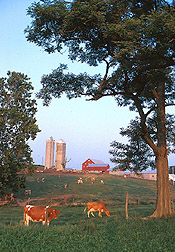This page has been archived and is being provided for reference purposes only. The page is no longer being updated, and therefore, links on the page may be invalid.
Read the magazine story to find out more. |
|
|
New Website Helps Manage Dairy Nitrogen
By Sharon DurhamMarch 12, 2007
A free, interactive website is now available to help dairy producers better manage nitrogen on their farms. It's the result of cooperative work by scientists with the Agricultural Research Service (ARS), Cornell University and the University of Vermont, funded by a U.S. Department of Agriculture (USDA) Fund for Rural America grant.
Though nitrogen is an essential nutrient for crop and animal production, feeding too much of it in livestock rations, or applying an excess as fertilizer or manure to crops, can increase its runoff into surface and groundwater, or its loss into the air. And since commercial feeds and fertilizers are significant—and expensive—sources of nitrogen, maximizing nitrogen use efficiency is very important to dairy producers and the public.
ARS soil scientist Jack Meisinger, with the Environmental Management and By-Product Utilization Laboratory at Beltsville, Md., helped develop "Nitrogen Management on Dairy Farms," which can be accessed at www.dairyn.cornell.edu. There, users will find 58 linked pages of mixed-media content covering management of crops and soils, feed storage, dairy herd nutrition and manure use.
The website is part tutorial, with interactive diagrams to aid in the review of information, as well as quizzes. Instruction is provided on sampling and testing manure, soil and crops for nitrogen. Information is also available on interpreting test results and calculating the amount of plant-available nitrogen present in a manure sample. Given the high cost of fertilizer, accounting for manure nitrogen can greatly improve farm profitability. A downloadable spreadsheet, called the "Manure Nutrient Calculator," is provided as an example of a manure-crediting system used in New York State.
State and federal research on managing the fate and transport of nitrogen in animal manure is used to formulate best-management practices. Case studies on the website illustrate how farms have made changes to reduce nutrient imbalances and losses by taking a whole-farm approach to nutrient management.
Read more about this research in the March 2007 issue of Agricultural Research magazine.
ARS is the USDA's chief scientific research agency.

